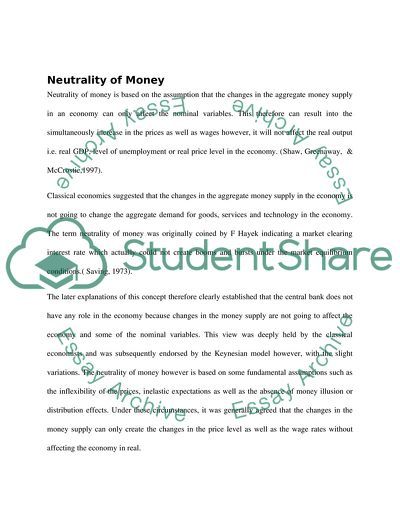Cite this document
(Neutrality of Money Coursework Example | Topics and Well Written Essays - 2000 words, n.d.)
Neutrality of Money Coursework Example | Topics and Well Written Essays - 2000 words. Retrieved from https://studentshare.org/macro-microeconomics/1748704-a-central-issue-in-monetary-economics-is-whether-money-is-neutral-what-is-meant-by-the-neutrality-of-money-and-what-is-the-position-adopted-on-this-issue-by-the-main-schools-of-macroeconomic-thought-you-should-write-about-2000-words-no-more-on-t
Neutrality of Money Coursework Example | Topics and Well Written Essays - 2000 words. Retrieved from https://studentshare.org/macro-microeconomics/1748704-a-central-issue-in-monetary-economics-is-whether-money-is-neutral-what-is-meant-by-the-neutrality-of-money-and-what-is-the-position-adopted-on-this-issue-by-the-main-schools-of-macroeconomic-thought-you-should-write-about-2000-words-no-more-on-t
(Neutrality of Money Coursework Example | Topics and Well Written Essays - 2000 Words)
Neutrality of Money Coursework Example | Topics and Well Written Essays - 2000 Words. https://studentshare.org/macro-microeconomics/1748704-a-central-issue-in-monetary-economics-is-whether-money-is-neutral-what-is-meant-by-the-neutrality-of-money-and-what-is-the-position-adopted-on-this-issue-by-the-main-schools-of-macroeconomic-thought-you-should-write-about-2000-words-no-more-on-t.
Neutrality of Money Coursework Example | Topics and Well Written Essays - 2000 Words. https://studentshare.org/macro-microeconomics/1748704-a-central-issue-in-monetary-economics-is-whether-money-is-neutral-what-is-meant-by-the-neutrality-of-money-and-what-is-the-position-adopted-on-this-issue-by-the-main-schools-of-macroeconomic-thought-you-should-write-about-2000-words-no-more-on-t.
“Neutrality of Money Coursework Example | Topics and Well Written Essays - 2000 Words”. https://studentshare.org/macro-microeconomics/1748704-a-central-issue-in-monetary-economics-is-whether-money-is-neutral-what-is-meant-by-the-neutrality-of-money-and-what-is-the-position-adopted-on-this-issue-by-the-main-schools-of-macroeconomic-thought-you-should-write-about-2000-words-no-more-on-t.


